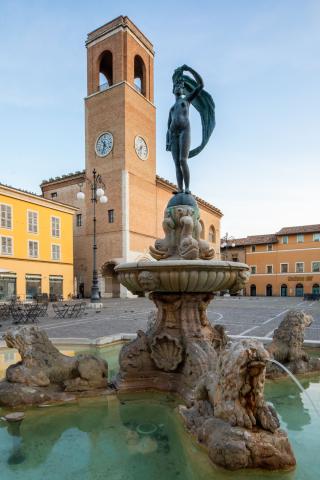If there is a place that more than others knows how to express the eclectic identity of Fano and its ability to harmoniously blend the many testimonies of its past, this is Piazza XX Settembre. The beating heart of the city, the fulcrum of city life today as in antiquity, in this square eras and architecture so distant and different coexist, in dialogue with each other, as to make it the symbol of the history of the city itself.
A story that has always had Fortune at its center for 2000 years!
Piazza XX Settembre in Fano is a unique crossroads of testimonies of the many eras that have marked the history of this city. Located in the center of Fano, the vital hub of the social and cultural life of the city, the square is the perfect summation of the history of Fano, the visible and the invisible.
Called Piazza Maggiore since the Middle Ages and only at the end of the nineteenth century called Piazza XX Settembre, the square opens at the foot of the fourteenth-century Palazzo del Podestà or della Ragione, now home to the Teatro della Fortuna. Next to the theatre, the Civic Tower dominates, rebuilt to replace the eighteenth-century bell tower demolished by retreating German troops in 1944, and Palazzo Bambini. On the façade of Palazzo Bambini, a sundial, now disappeared, performed the function of a solar calendar and showed the Middle South of Central Europe and the True South of Fano. Through the monumental Borgia-Cybo Arch from the end of the 15th century, from the Palazzo del Podestà, you can access the Malatesta Court. The only religious building in the square and one of the oldest in the entire historic centre, the church of San Silvestro, also known as Madonna di Piazza due to the seventeenth-century painting of the Madonna di Piazza attributed to Giovanni Baglioni. Under the pavement, characterized by a large central star from the 18th century, the invisible square opens up: conspicuous archaeological remains from the Roman era, kept in the basement of the Municipality Information Office and the Palazzo Malatestiano, in the cellars of Palazzo Bambini, under the stalls of the Teatro della Fortuna, in the foundations of the Civic Tower, remind us of the origins and foundations of the city.
But it is on the western side, the one overlooking Corso Matteotti, that the symbol of Piazza XX Settembre and of the entire city stands: the Fountain of Fortune where the bronze statue of the Goddess of Fortune stands out, proud and indomitable.
The fountain, with its large polychrome marble basin, was entirely renovated in 1697-99 by the Venetian Ludovico Torresini. The original structure consisted of an octagonal marble basin, without sculptural decorations. The fountain was fed by the Roman aqueduct via terracotta pipes up to the fountain in the Molino square, near the Arch of Augustus, and subsequently via lead and terracotta pipes up to the square. The bronze statue of the Goddess Fortuna was created in 1593 by the Urbino artist Donnino Ambrosi, but due to its excessive nudity, it was placed in a niche of the Palazzo dei Priori and replaced by a large bronze vase. The controversy over where to place the statue lasted more than a century, until it was finally placed on the fountain in 1611. Currently, the bronze statue is kept in the Civic Museum, while a copy was placed on the fountain.
The statue of the Goddess Fortuna has a peculiarity: if you carefully observe the figure, a discrepancy emerges between the veil and the hair of the goddess Fortuna: the veil fluctuates in one direction, while the hair moves in the opposite direction.
